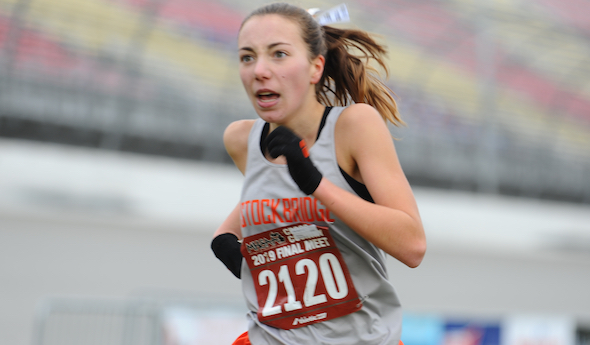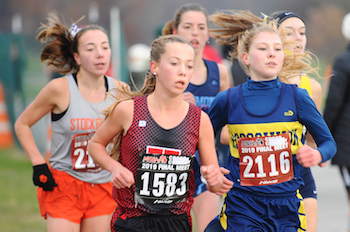
Tolson, 3-Peater Hart Find Winning Plans
November 2, 2019
Second Half reports
BROOKLYN – Rylee Tolson got her rookie mistakes out of the way last year.
Running for the first time in the MHSAA Lower Peninsula Division 3 cross country championship, Tolson was too wired, burning up needed energy before she ever started the race.
“It was a rough experience, but it was definitely a learning experience,” the Stockbridge sophomore said. “Last year, I was really, really nervous. I got myself all pumped up. I was running all over the place before. I learned I have to relax, stay calm and focus on the job that is in front of me.”
That approach served Tolson well when she approached the track Saturday at Michigan International Speedway in a six-way battle for the championship.
She took the lead at the 2.5-mile mark of the 3.1-mile race and focused on her pre-race plan to maintain her lead over a hard-charging pack. She finished in 18:31.4, winning by 7.6 seconds over Maddy Bean of Richmond.
“Our plan was every 100 meters I’ve got to think, ‘I’ve got to pick this up. I’ve got to push harder, harder, harder every 100 meters,’” she said.
 As a freshman, Tolson finished 20th in the Division 3 meet in 19:48.7 after winning the Regional. She maintained her composure Saturday even though she had a momentary freak-out moment leading the race coming down the long straightaway.
As a freshman, Tolson finished 20th in the Division 3 meet in 19:48.7 after winning the Regional. She maintained her composure Saturday even though she had a momentary freak-out moment leading the race coming down the long straightaway.
“It was scary,” she said. “I thought she was right behind me. I’m like, ‘Oh, my goodness.’ I said, ‘Let’s not focus on what’s behind me; let’s focus on what’s in front of me. Let’s do my best to be the best that I can be.’”
For Bean, taking second place was a huge accomplishment after placing 40th in Division 3 as a sophomore and 78th in Division 2 as a junior.
“Once we got on the track, we spread out,” Bean said. “I knew it was now or never. She was cooking. It’s nerve racking, because you never know. But it’s awesome at the same time, because the spectators help. It’s just surreal being here.”
Hart won its third straight team championship by a 77-133 margin over Shepherd. Grandville Calvin Christian was third with 136 points.
Hart put three runners in the top nine in the team race. Savannah Ackley was fourth overall and second among team runners in 18:49.0, followed by Audrianna Enns in fifth overall and third in the team race in 18:56.2.
Lynae Ackley was 14th overall and ninth in the team race in 19:26.2. Completing Hart’s scoring were MacKenzie Stitt (42nd in 20:11.6) and Brenna Aerts (77th in 20:20.4).
PHOTOS: (Top) Stockbridge’s Rylee Tolson pushes toward the finish of the Division 3 Final at Michigan International Speedway. (Middle) Hart’s Savannah Ackley (1583) paces the lead pack, including Tolson, earlier in the race. (Photos by Dave McCauley/RunMichigan.com.)

MHSAA Vault: MIS Rose to Challenges to Host 2020 LP Finals
By
Rob Kaminski
MHSAA benchmarks editor
November 12, 2021
The “MHSAA Vault” features stories from past publications and other documents in the MHSAA Library. This issue takes a look at the MHSAA Cross Country Finals at Michigan International Speedway, which celebrated 25 years in 2020 – although it was an event that nearly didn’t happen last fall …
In 1996, the MHSAA and Michigan International Speedway began a partnership the changed the course of the Lower Peninsula Cross Country Finals – quite literally.
The land in and around the track at Brooklyn would host the Finals for all classes of runners in one place on one day, an annual festival of nearly 2,000 runners competing for the MHSAA’s top honors.
Even skeptics – and there were several among running purists who thought the course was too flat, for example – can’t deny the results.
Finals attendance nearly doubled in that first year, and crowds in excess of 10,000 have enjoyed a day of racing several times, including a record 12,153 in 2011.
Enthusiastic crowds were the norm in recent years, with 11,232 in 2017, and nearly 11,000 in 2018 (10,989) and 2019 (10,873).
In fact, attendance failed to reach at least 8,000 only twice since the move to MIS.
Of course, last year was an exception, when attendance was limited to 1,000 spectators per session due to the COVID-19 Pandemic. Fans also were restricted to the grandstands rather than following the action throughout locations on the course.
To reduce the number of runners in each race, the event was spread over two days, with each Division being run in two separate “sections” with times then combined at the end to determine team and individual champions.
While not ideal, the end result was another year of fantastic efforts at MIS – both from student-athletes and those behind the scenes.
“Even at the last hour, less than a week ahead of the Finals, we were closer to not having the Finals than we were to having them,” said MHSAA Assistant Director Cody Inglis, who coordinates the cross country postseason. “Rumors and challenges of mandated shutdowns, testing and other requirements were being discussed and caused a lot of unknowns. Even at the Regional level, we had schools, Regional courses and hosts shutting down their facilities; we had to relocate four Regionals 48 hours prior to race times. That scenario just could not happen at the Finals level where far more runners and much more travel would be involved.”
Among the many last-minute hurdles was the edict from NASCAR – which owns MIS – that all persons on site be temperature checked upon entry. That meant securing thermometers that were easy to operate in short order, along with personnel necessary to conduct the readings.
The attendance limitations certainly helped to implement the temperature screening, but brought their own issues.
“Limiting spectators was not a popular decision, but it really was the only way to have a race,” Inglis said. “We were taking direction and working with policies and protocols from the MDHHS, the Governor’s office, Lenawee County Health Department, MIS and NASCAR.”
Part of the solution was to utilize the grandstands as a “barrier” between participants and spectators. The reduced number of fans were dispersed over thousands of seats while still allowing them the chance to watch their student-athletes compete.
“It wasn’t the same, it wasn’t easy or perfect, but it was what we had to do to have a race,” Inglis said. “Separating the Finals into two days and different sections also allowed us to spread out the event and limit the number of people on site at any one time. This was a key part of the plan and worked well even though it separated races within a Division.”
The MHSAA, MIS and the cross country community never lost focus of the main goal: a culmination of the season for the student-athletes, who deserved something last year more than ever. And, more than ever, MIS once again displayed its advantage as a venue that could adapt to the fluid nature of the times to pull off the event.
“There were some thoughts of using four different sites, but as we learned during the Regionals, the climate of things was so tenuous from one area of the state to another that we couldn’t be 100-percent certain that there wouldn’t again be last-minute cancelations,” Inglis said. “MIS was wonderful to work and collaborate with, and was the best option to get it done. It was never mentioned once publicly about the possibility of not having the Finals – only how we could best do it under uncharted conditions.”
The moving parts and ever-changing scenarios created more complexity than ever in finalizing a season, but every decision was made with the complete desire to conduct the Finals as close to normal as possible.
“I firmly believe that a finish to the season, no matter the differences in race formatting and fan experience, was something everyone would have taken when the season began in August,” Inglis said.
Indeed, the finish line in Year 25 at MIS might have been the most gratifying of them all.

